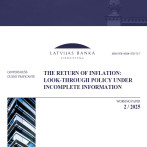Domestic factors behind continued low inflation in Latvia
In September 2012, with the consumer price level rising by 0.5%, the annual inflation remained low at 1.8%.
As a result of seasonal factors, it was mostly the prices of wearing apparel and footwear that grew (5.0% month-on-month), yet the increase did not exceed the average for the previous years. The impact of the season and global prices was felt in food prices: the global food price index that is substantially influenced by grain prices grew relatively little and was no longer determined by grain prices as was the case, for example, in July, but by milk and meat prices that are justified by a rise in the costs of cattle feed and sustained demand. In Latvia, the purchasing prices of grain are stabilizing[1] and should not exert an additional pressure on inflation.
Compared with August, fuel prices also rose, however, the average oil price in September remained relatively stable and even dropped in the second half of the month, already bringing down the retail price for fuel somewhat. The beneficial impact of oil prices will likely be reflected in the October inflation as a lessening component.
Overall, however, the annual inflation could slightly rise in October as a result of so-called base factors, for last year at the outset of the new heating season, thermal energy tariffs were reduced. This season, the average tariff level could match the existing one (let us remember that thermal energy appreciated at the beginning of 2012), although several producers of thermal energy, e.g., "Liepājas enerģija", "Sabiedrība Mārupe", "Iecavas siltums", as a result of functioning cogeneration stations or under the impact of other factors will offer (or are planning to offer)[2] lower tariffs to the consumers.
It is not a mass phenomenon and there are other producers of thermal energy who, at the beginning or middle of the season may raise the thermal energy tariffs since the costs of fuel (oil products or natural gas) have risen and they have invested in their infrastructure. Thus, e.g., "Rūjienas siltums" wants to offer an approximately 25% higher tariff because of higher costs of fuel, noting that the effective tariffs are older than the ones offered by other suppliers of thermal energy. In Riga, as two of the so-called “green” heating plants are put into operation, the thermal energy tariffs could drop by a couple of percent only in the next heating season if other factors do not promote a rise in tariffs. The average price of oil and related products (e.g., natural gas) is also not lower than what it was in the same period a year ago and thus the prices of fuel do not have a substantial reason to drop right now.
Annual core inflation in September continued to drop (indicating that the demand side pressure on prices has not been renewed) reaching -0.3%. The substantial impact here was from the annual drop in consumer prices of such large components as wearing apparel and footwear, household furnishings and equipment, purchases of transport vehicles etc.
Consumer price data regarding the European Union will be published in mid-October and then we will be able to evaluate the fulfilment of the Maastricht inflation criterion in Latvia. Right now it is evident that in September, in accordance with national methodology, the 12-month average inflation in Latvia reached 2.9%. The 12-month average harmonized consumer price index can be expected to be similar and in the Maastricht criterion evaluation level could be reached as early as September.
[1] LTVC is publishing the latest monthly and weekly data on the purchasing prices of grain: right now it is possible to compare the August average and the average for the week of 24-30 September.
[2] In some locations approval is still pending; e.g., in Liepāja a greater drop in tariffs than the supplier demanded was approved.
Textual error
«… …»






